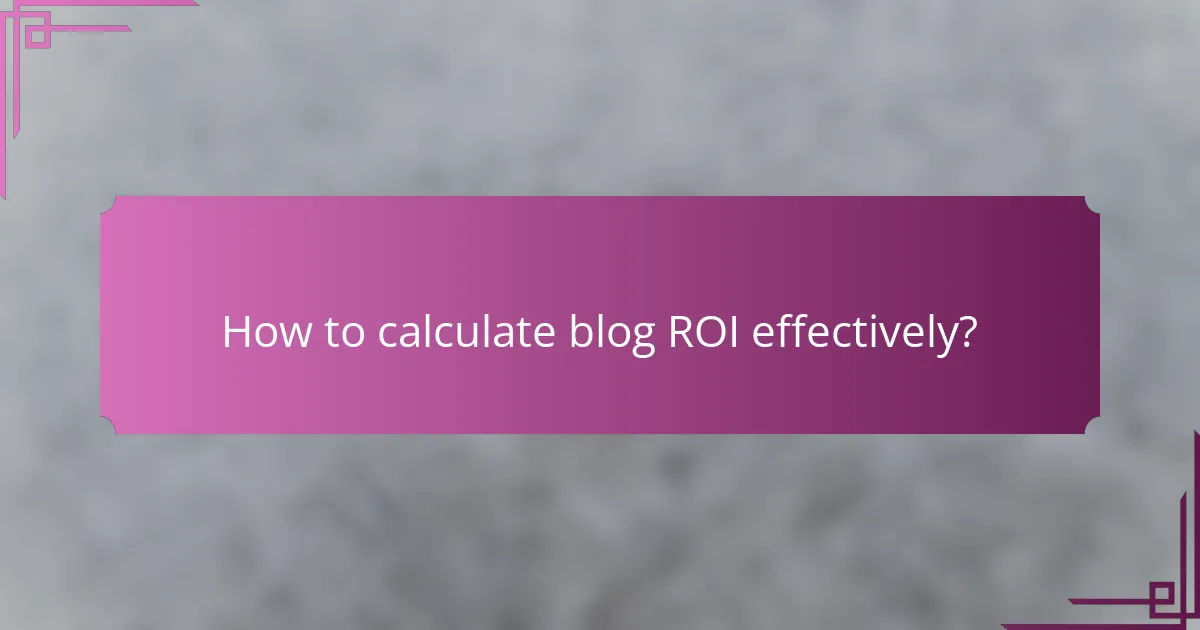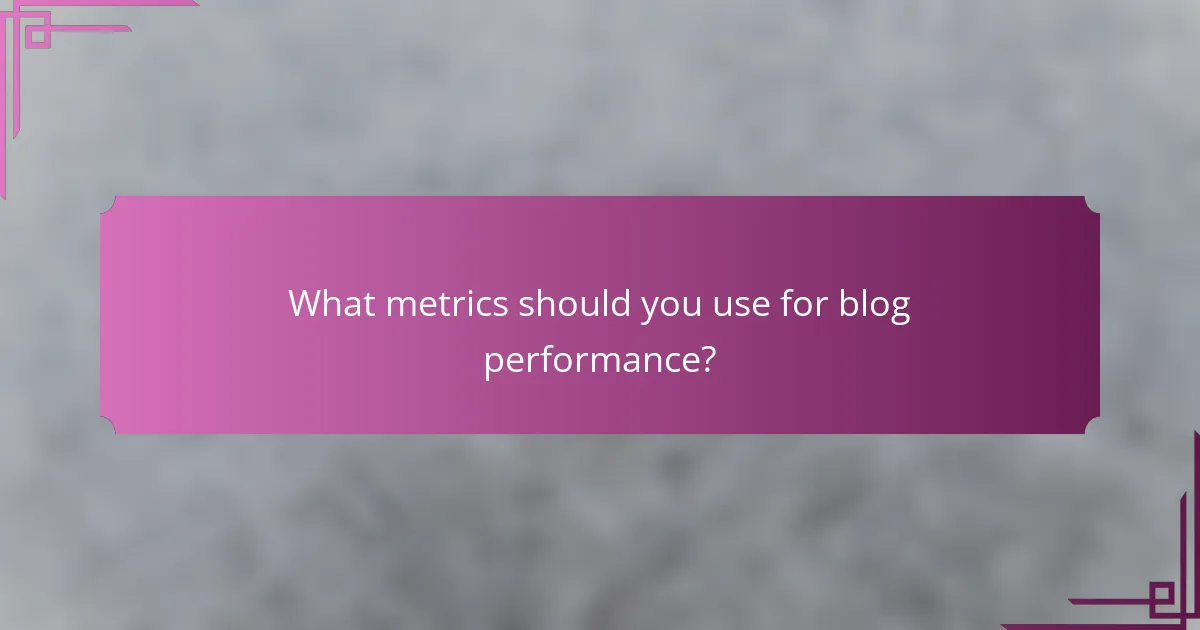Understanding the return on investment (ROI) of your blog is crucial for measuring its financial success and overall effectiveness. By calculating the revenue generated against the costs of content creation, marketing, and maintenance, you can gain valuable insights into your blog’s performance. Additionally, focusing on key metrics such as traffic sources, engagement levels, and conversion rates will help you evaluate how well your content resonates with your audience.

How to calculate blog ROI effectively?
To calculate blog ROI effectively, you need to assess the financial return generated by your blog relative to the costs incurred in its creation and maintenance. This involves quantifying both the revenue generated and the expenses associated with content production, marketing, and hosting.
Formula for ROI calculation
The basic formula for calculating ROI is: ROI = (Net Profit / Total Investment) x 100. In the context of a blog, net profit is the revenue generated from the blog minus the costs of running it. Total investment includes expenses such as content creation, marketing, and any tools or platforms used.
For example, if your blog generates $1,000 in revenue and costs $300 to maintain, your ROI would be: ROI = (($1,000 – $300) / $300) x 100 = 233%. This indicates a strong return on investment.
Key metrics for evaluation
Several key metrics are essential for evaluating blog ROI. These include traffic volume, conversion rates, and average revenue per visitor. Traffic volume indicates how many visitors your blog attracts, while conversion rates show the percentage of those visitors who take a desired action, such as signing up for a newsletter or making a purchase.
Another important metric is the average revenue per visitor (ARPV), which helps you understand how much revenue each visitor generates. By tracking these metrics over time, you can identify trends and make informed decisions to improve your blog’s performance.
Common pitfalls in calculation
One common pitfall in calculating blog ROI is failing to account for all expenses. Many bloggers focus solely on direct costs like hosting and content creation, neglecting marketing expenses or tools that enhance productivity. Ensure you include all relevant costs to get an accurate picture of your ROI.
Another mistake is not tracking metrics consistently. Without regular monitoring of traffic, conversions, and revenue, it becomes challenging to assess the effectiveness of your blog accurately. Establish a routine for data collection and analysis to avoid this issue.

What metrics should you use for blog performance?
To effectively evaluate blog performance, focus on metrics that reveal how well your content attracts, engages, and converts visitors. Key metrics include traffic sources, engagement levels, and conversion rates, each providing insights into different aspects of your blog’s effectiveness.
Traffic sources analysis
Traffic sources analysis helps you understand where your visitors are coming from, which is crucial for optimizing your marketing efforts. Common sources include organic search, social media, direct visits, and referrals. By analyzing these sources, you can identify which channels are most effective and allocate resources accordingly.
Utilize tools like Google Analytics to track traffic sources. Look for trends over time; for instance, if social media referrals increase, consider enhancing your social media strategy. Aim for a balanced mix of traffic sources to ensure sustainability.
Engagement metrics
Engagement metrics measure how visitors interact with your blog content, indicating its relevance and quality. Key metrics include average time on page, bounce rate, and pages per session. High engagement typically correlates with valuable content that resonates with your audience.
To improve engagement, focus on creating compelling headlines, using visuals, and incorporating interactive elements. Monitor these metrics regularly; for example, a bounce rate above 70% may signal that your content isn’t meeting visitor expectations.
Conversion rates
Conversion rates indicate the percentage of visitors who complete a desired action, such as signing up for a newsletter or making a purchase. This metric is vital for assessing the effectiveness of your blog in driving business goals. A good conversion rate can vary widely by industry but generally falls between 1-5% for blogs.
To enhance conversion rates, ensure your calls to action (CTAs) are clear and compelling. A/B testing different CTAs can provide insights into what resonates best with your audience. Avoid common pitfalls like overwhelming visitors with too many options, which can dilute focus and reduce conversions.

How does display advertising impact blog ROI?
Display advertising can significantly enhance a blog’s return on investment (ROI) by generating revenue through ad placements and driving traffic. Effective strategies in ad management can lead to increased earnings while optimizing user experience.
Revenue generation through ads
Display ads can create a steady stream of income for bloggers, especially when they attract substantial traffic. Revenue is typically generated through various models, including pay-per-click (PPC) and pay-per-impression (PPI), allowing bloggers to choose the best fit for their audience and content.
For instance, a blog that receives thousands of monthly visitors can earn hundreds to thousands of dollars, depending on its niche and audience engagement. High-traffic blogs in lucrative sectors like finance or technology often see higher ad revenue compared to those in less profitable areas.
Ad placement strategies
Strategic ad placement is crucial for maximizing visibility and click-through rates. Ads should be positioned where they are most likely to be seen, such as above the fold, within content, or at the end of articles. Experimenting with different placements can help identify what works best for your audience.
Additionally, using A/B testing can provide insights into which ad formats and locations yield the highest engagement. Avoid overwhelming readers with too many ads, as this can lead to a negative user experience and decreased traffic.
Cost per click vs. cost per impression
Understanding the difference between cost per click (CPC) and cost per impression (CPM) is essential for optimizing ad revenue. CPC charges advertisers only when a user clicks on an ad, while CPM charges based on the number of times an ad is displayed, regardless of clicks.
Choosing between these models depends on your blog’s traffic and audience behavior. If your audience is likely to engage with ads, CPC may be more profitable. Conversely, if your blog has high traffic but lower engagement, CPM could provide more stable income. Regularly reviewing performance metrics will help in making informed decisions.

What are the best practices for evaluating blog performance?
Evaluating blog performance effectively involves systematic approaches that focus on key metrics and actionable insights. Best practices include conducting regular audits, benchmarking against competitors, and utilizing analytics tools to gather data and drive improvements.
Regular performance audits
Regular performance audits help identify strengths and weaknesses in your blog. These audits should assess content quality, engagement metrics, and SEO performance to ensure alignment with your goals.
Consider conducting audits quarterly or biannually, focusing on metrics such as page views, bounce rates, and average time on page. This frequency allows for timely adjustments and strategic planning.
Benchmarking against competitors
Benchmarking against competitors provides context for your blog’s performance. By comparing key metrics such as traffic, engagement rates, and social shares, you can identify areas for improvement.
Use tools like SimilarWeb or SEMrush to gather competitor data. Aim to analyze at least three to five competitors to establish a realistic performance baseline and set achievable goals.
Utilizing analytics tools
Utilizing analytics tools is essential for tracking and interpreting blog performance data. Google Analytics is a popular choice, offering insights into user behavior, traffic sources, and conversion rates.
Set up specific goals within these tools to measure success accurately. Regularly review dashboards to monitor trends and adjust your content strategy based on data-driven insights.

How to improve blog ROI over time?
Improving blog ROI involves enhancing content quality, targeting the right audience, and optimizing for search engines. By focusing on these areas, you can increase engagement, drive traffic, and ultimately boost revenue from your blog.
Content optimization techniques
Content optimization is essential for maximizing blog ROI. Start by ensuring your posts are well-structured, engaging, and relevant to your audience’s interests. Use compelling headlines, subheadings, and visuals to keep readers engaged.
Consider updating older content to reflect current trends or information, which can enhance its value and relevance. Regularly analyze performance metrics to identify which topics resonate most with your audience, allowing you to refine your content strategy accordingly.
Audience targeting strategies
Effective audience targeting is crucial for improving blog ROI. Begin by defining your target demographic based on factors like age, location, interests, and online behavior. Use tools like Google Analytics to gather insights about your current audience and tailor your content to meet their needs.
Engage with your audience through social media and email newsletters to build a community around your blog. Personalizing content based on audience segments can significantly enhance engagement and conversion rates.
SEO enhancements
SEO enhancements are vital for increasing organic traffic and improving blog ROI. Start by conducting keyword research to identify terms your target audience is searching for. Incorporate these keywords naturally into your content, titles, and meta descriptions.
Optimize your blog’s loading speed and mobile responsiveness, as these factors influence search rankings. Regularly update your SEO practices to align with search engine algorithm changes, ensuring your content remains visible to potential readers.

What frameworks exist for assessing blog ROI?
Several frameworks can help evaluate the return on investment (ROI) of a blog, focusing on both qualitative and quantitative metrics. These frameworks enable businesses to measure the effectiveness of their content strategy and understand its impact on overall goals.
ROI decision matrix
The ROI decision matrix is a tool that helps businesses weigh the benefits of their blog against the costs involved. It typically includes factors such as content creation expenses, promotional costs, and the revenue generated from leads or sales attributed to the blog.
To create an effective ROI decision matrix, list all relevant costs and potential benefits. For example, if a blog post costs $500 to produce and generates $2,000 in sales, the ROI can be calculated as follows: (Revenue – Cost) / Cost = ($2,000 – $500) / $500 = 3, or 300% ROI.
Performance evaluation frameworks
Performance evaluation frameworks focus on specific metrics to assess how well a blog meets its objectives. Common metrics include traffic, engagement rates, conversion rates, and social shares. Each metric provides insights into different aspects of blog performance.
For instance, tracking traffic through tools like Google Analytics can reveal how many visitors a blog receives, while engagement metrics such as average time on page can indicate content quality. It’s crucial to set benchmarks for these metrics based on industry standards to gauge success accurately.
Additionally, consider using a combination of qualitative feedback, such as reader comments and surveys, alongside quantitative data to gain a comprehensive view of your blog’s performance. This holistic approach ensures that both the financial and experiential aspects of ROI are considered.


